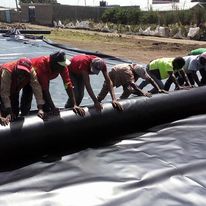Certainly!
Custom Liners for Dams: An In-Depth Exploration
Introduction
Custom liners for dams are crucial components in modern dam engineering, providing essential functions such as water containment, erosion protection, and structural reinforcement. This article explores the design, manufacturing, installation, and benefits of these liners, highlighting how they are tailored to meet the specific needs of different dam projects.
1. Understanding Dam Liners
1.1 Definition and Purpose
Dam liners are protective membranes designed to cover the surfaces of dams, often the reservoir bed or the face of the dam structure. They play a critical role in:
- Water Retention: Preventing leakage and ensuring water is contained within the reservoir.
- Erosion Control: Protecting the underlying materials from erosion caused by water flow.
- Structural Integrity: Enhancing the longevity and stability of the dam.
1.2 Types of Liners
- Geomembranes: Made from synthetic materials such as HDPE (High-Density Polyethylene), PVC (Polyvinyl Chloride), and EPDM (Ethylene Propylene Diene Monomer). These are commonly used for their durability and resistance to chemicals and UV rays.
- Geosynthetic Clay Liners (GCLs): Composed of a layer of bentonite clay sandwiched between geotextiles, providing excellent water impermeability.
- Concrete Liners: Pre-cast or poured concrete solutions used in combination with other materials for added protection.
External Link: Geomembranes Overview
2. Design Considerations
2.1 Site-Specific Factors
- Geological Conditions: Understanding soil and rock types, as these affect liner choice and installation techniques.
- Water Chemistry: The chemical composition of the water in the reservoir can influence liner material selection.
- Climate: Temperature variations and weather conditions play a role in determining the best materials and installation methods.
2.2 Liner Specifications
- Thickness and Strength: Must be adequate to withstand the pressure and environmental conditions specific to the dam.
- Seam Integrity: Ensuring seams are well-sealed to prevent leaks.
- Durability and Longevity: Liners should be designed to last for the expected lifespan of the dam.
External Link: Design Principles for Geosynthetics
3. Manufacturing and Materials
3.1 Material Properties
- HDPE Liners: Known for their chemical resistance and flexibility. Ideal for applications with potential exposure to aggressive chemicals.
- PVC Liners: Provide a good balance between cost and performance, especially in less aggressive environments.
- EPDM Liners: Highly resistant to UV radiation and extreme temperatures.
3.2 Custom Fabrication
Liners can be custom-fabricated to fit the exact dimensions and contours of a dam. This often involves:
- Site Surveys: Detailed measurements and topographical studies.
- Material Testing: Ensuring the chosen material meets all required specifications.
External Link: HDPE Liner Specifications
4. Installation Process
4.1 Preparation
- Surface Preparation: Cleaning and leveling the surface to ensure good adhesion and performance of the liner.
- Subgrade Testing: Assessing the subgrade to ensure it is suitable for liner installation.
4.2 Installation Techniques
- Laying the Liner: Positioning the liner material according to design specifications.
- Seaming and Welding: Techniques like extrusion welding or thermal fusion are used to join sections of the liner.
- Quality Assurance: Inspection and testing to ensure there are no leaks or weaknesses.
External Link: Installation Guidelines for Geomembranes
5. Maintenance and Monitoring
5.1 Regular Inspections
Routine inspections are essential to:
- Identify Wear and Tear: Early detection of potential issues such as tears or punctures.
- Evaluate Performance: Ensuring the liner continues to meet its design criteria.
5.2 Repair and Replacement
- Patch Repairs: For minor damage, patching techniques can be used to fix small issues.
- Complete Replacement: For significant damage or wear, replacing sections of the liner may be necessary.
External Link: Liner Maintenance Best Practices
6. Case Studies
6.1 Successful Applications
- Case Study 1: A large dam using HDPE liners to prevent seepage and maintain structural integrity.
- Case Study 2: The use of PVC liners in a dam with less aggressive water conditions.
6.2 Challenges and Solutions
- Case Study 3: Addressing issues with liner installation in complex geological conditions.
- Case Study 4: Innovations in liner materials that improved performance in extreme climates.
External Link: Case Studies in Geosynthetics
Conclusion
Custom liners for dams are an essential technology in modern civil engineering, offering significant benefits in water retention, erosion control, and structural support. The development, installation, and maintenance of these liners require careful consideration of material properties, site-specific conditions, and ongoing monitoring to ensure long-term performance.
For further reading and detailed technical resources, the links provided offer valuable insights into the materials, design principles, and case studies related to dam liners.

